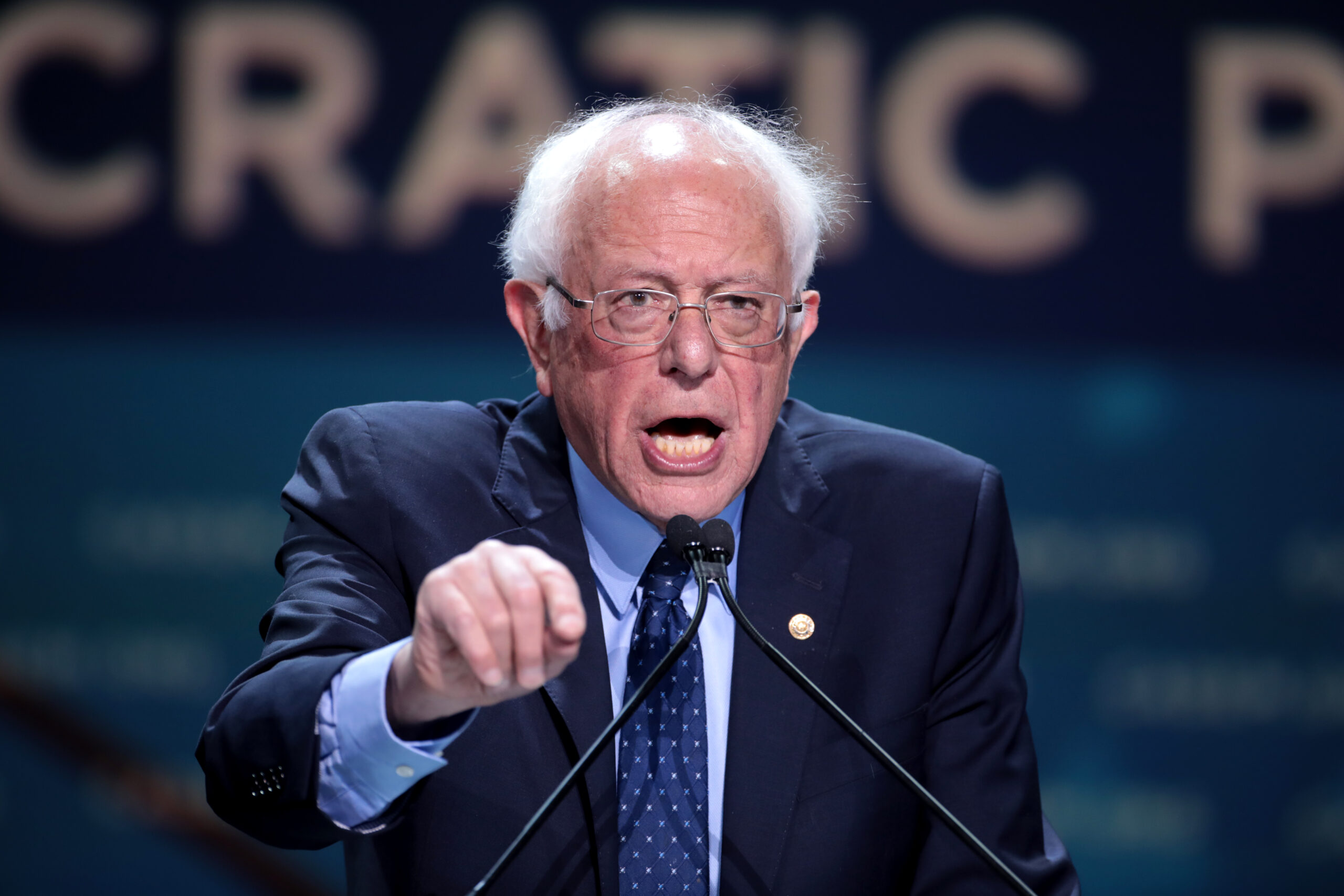*Special Note: In some ways, this is a sequel or companion piece to the “What is the Point of the Moderate Democrat?” post. I suggest reading it first or making it your next read.*
This post is rife with terminology issues. Obviously, all Progressives can’t be losing primaries, or the U.S. Senator pictured above wouldn’t be a Senator. Therefore, while we’ll look at select downticket races, I’ll mainly be writing about winning the Democratic presidential nomination. Terms like progressive, liberal, moderate, etc. can have various definitions depending on the time period and context. For example, the New Deal Democrats like FDR look pretty progressive on most issues by today’s standards and secured nominations, despite primaries playing a very different role back then. For our context, which will primarily be focused on politics during and after the 1980s, we’ll think of Progressives as candidates with political positions to the left of the eventual Democratic nominee on key issues. These will typically be candidates with low or no connections to the Democratic Leadership Council or otherwise not identified as a New Democrat.[i]
Let’s not belabor ourselves with technicalities while discussing Progressives losing primaries. We know that Moderates have successively won the Democratic Party’s presidential nomination since 1992. And usually there are Progressive candidates who come up short or never had a real shot. While it is not 100% the case in downticket races, we’re still surprised when a Progressive candidate beats a Moderate. For example, The New York Times called Rep. Alexandria Ocasio-Cortez’s win against former Rep. Joe Crowley a “major upset.”[ii]
Despite this, Progressives are having an impact. Many key Progressive priorities poll well[iii], and voters are responding to candidates that are channeling Progressive policies and priorities, even if the candidate doesn’t accept the Progressive label.[iv] Even President Biden adopted a more Progressive sounding tone in the 2020 primaries.[v]
Overall, though, Progressives have not landed the presidential nomination in this political era. Sen. Sanders made a strong push and arguably came close twice. But Perry Bacon Jr., a Washington Post and FiveThirtyEight columnist, thinks that Progressives are still very far away from the nomination. He estimates a Progressive candidate would lose 70-30 in the primaries.[vi] Furthermore, Progressive-Moderate disagreements on topics ranging from Biden’s agenda[vii] to the term “moderate” itself[viii] still make the headlines and op-ed pieces regularly, reinforcing the ever constant “Democrats in Disarray” narrative. With the overturning of Roe, President Biden’s waning approval rating[ix], and Democrats losing all 27 toss-up House races and key Senate races in 2020,[x] it appears the Progressive-Moderate rift will continue indefinitely.
This has left me wondering what Progressives are missing strategically. Previously, I’ve written about how Moderates need to update their strategic assumptions, and it only seems fair to discuss the Progressives now. Because with Trumpian-authoritarian Republicans becoming more common, we need the Democratic Party to be at its best, especially with the upcoming Republican takeover of the House of Representatives. In this post, we’ll look at Progressives’ positioning on issues and prior presidential primary strategies. And we’ll make recommendations for future primary strategies.
Before getting started, I don’t currently think Progressives should challenge President Biden for the nomination in 2024. There is a losing history within both parties when sitting Presidents get challenged. While I reserve the right to change my mind with further analysis and in response to future developments, let’s just assume that this advice is for 2028 or later.
Progressive Issue Positioning
Unlike in prior years, Progressives don’t have an Overton Window problem for most of their priorities. Their positions sit well within the frame for public debate. Medicare for All, one of the Progressives’ stickiest wickets, has increased in popularity. Kaiser Family Foundation, Pew Research Center, Morning Consult, and The Hill have all published polls with support ranging from 53% to 69% support for Medicare for All or some increased government role in providing health insurance.[xi] As I mentioned in my post “What’s the Deal with Student Loan Cancellation?”, that policy is also popular. The Wealth Tax and free tuition at public universities is popular.[xii] Even support for legalizing marijuana is at an all-time high at 68%.[xiii] For those who discount general popularity by focusing on specific segments, you can look at the cross-tabs and find support or at least a strong starting point across key demographics, including non-college educated white voters who are largely linked to support for Trump.[xiv] Unlike prior Progressive presidential candidates, like former Rep. Dennis Kucinich[xv], the current era of Progressive candidates have a stronger launching point for campaigns.
But we all know popular policies are not enough. Political campaigns are infamous for distorting popular policies into fatal candidate flaws. For better or worse, voters consider more than just issues. And a candidate can still lose with a popular platform.
Standard Progressive Strategies
Based on observation, the Progressives are pursuing four strategies to capture the nomination. First is changing the party from within. This is evidenced by the Biden-Sanders Unity Platform, and the Congressional Progressive Caucus (“CPC”). Both methods facilitate debate internally and push policy alternatives with the politicians themselves. The goal of this strategy is to turn policies into the standard which Democrats use during their presidential campaigns. Moderates attempted the same thing in the mid-80s with their policies and made very little impact. The biggest problem with this strategy is the need for consensus, which is difficult to gain with a room full of politicians. For example, the CPC had a lack of consensus last year on infrastructure.[xvi]
In a related strategy, Progressives have also provided token primary opposition in attempts to move Moderates to the left. Former Rep. Dennis Kucinich’s presidential runs are a good example of this. In 2004, Kucinich was “the voice for getting out of Iraq . . . For universal single-payer health care. For getting out of NAFTA and the WTO. For having our children go to college tuition-free,” and was defeated soundly for his effort.[xvii] In 2016, Sen. Sanders ran for President seemingly out of obligation to “get the progressive agenda taken more seriously” after the Obama years.[xviii] In business, this would be viewed as a “participation” strategy.[xix] The problem with participation strategies is that it takes time, resources, and brain power away from finding winning strategies and implicitly concedes that you can’t hit your goals.
The 2020 election produced the last two strategies for our analysis. First is Sen. Elizabeth Warren’s strategy. She tried to find a path between Sen. Sanders and the various Moderates in the 2020 field. She set out as a Progressive who had an endless list of policy solutions. However, when pressured for details:
[S]he was criticized by those on the left for compromising too much and by centrists for the sheer size of the plan. The episode captured a fundamental pain point for her candidacy: She was too much of an insider for those demanding revolution, and too much of an outsider for those who wanted to tinker with the system and focus on beating Mr. Trump.[xx]
As shown by the Iowa polling, Sen. Warren’s attempt to create a new path at the crossroads between Progressives and Moderates led to steady decline.[xxi]
Lastly, Sen. Sanders learned from 2016 that he could win. Sen. Sanders attempted to expand his base by bridging his economic stances with racial equality issues.[xxii] He also made more tactical changes by offering a foreign policy platform and ramping up fundraising.[xxiii] But, just based on observation again, it appears Sen. Sanders focused on more of the moral argument for his policies.[xxiv] Of course, I think morals are important, but you can put people on the defensive easily when they don’t immediately agree with you. This is different from stating your case and providing a path for people to agree with you. Sen. Sanders’ approach can leave little room for people to buy-in. It can also add to electability concerns which is a topic that is traditionally dominated by Moderates.[xxv] In the face of Trump and Trump-like candidates, Democratic primary voters will want to know how your message will expand and how it will win over the broader public.
Recommendations
The four standard progressive strategies all have significant drawbacks. Building consensus within the party will take time, and those efforts are easily ignored once campaign season has begun. Participating in primaries to pull Moderates to the left uses a lot of energy and resources while simultaneously conceding that Progressives can’t win. Running between Progressives and Moderates can leave you in a “voter desert,” and strictly making the moral argument can leave voters out and have them questioning your electability. So, what is a Progressive to do?
In many ways, Progressives need to finish the work. Moderates were in a similar position in 1988. In response to a lackluster showing in the 1988 presidential primary, the Democratic Leadership Council answered by creating a think tank, ramping up fundraising, expanding membership, offering its most promising candidates a chairperson position (most notably then-Arkansas Gov. Bill Clinton), which opened national networking opportunities, and built strong messaging around their policies and agenda. With then-Gov. Clinton as its standard-bearer, the New Democrats took over the party, defeated President George H.W. Bush, and put us on the Moderate-driven path we’re on today. For Progressives to put together a Presidential primary win, they need to match this framework immediately.
Unlike the Moderates in 1988, the Progressives have a lot of pieces already. There is certainly no shortage of think tanks and fundraising, and building a national network is a different and more open exercise compared to 1988. However messaging, specifically framing, needs a good deal of work. For example, popularity for Medicare for All can swing 17-points just based on terminology.[xxvi] Building persuasive issue and agenda framing and driving that message in the media is a necessary crucial step.
Framing also helps set a comprehensive vision for the country. Moderates were also missing this before President Clinton but, obviously, gained it in 1992. This vision also provides a dominant logic for voters to understand how policies fit together and how a candidate would respond to unforeseen events. This generates overall comfort in Progressive leadership and makes it easier to earn trust as well as votes. Overall; issue framing, a supporting media infrastructure, and consistent candidate and pundit messaging are remaining steps for Progressives to reach the Presidential nomination and lay the groundwork for codifying Progressive policies.
Conclusion:
Simply put, the Progressives have a lot of work to do. And in a time where the Democratic Party can’t afford a lot of losing, Progressives must learn from the Moderate’s story and complete their own hard work of putting out consistently good candidates with well-framed issues. It will take conscious effort and well-crafted study, but it is certainly attainable because of the work done up to this point.
Sources:
Picture Source: Wikimedia Commons
[i] For more detail on this, please visit my post “What’s the Point of a Moderate Democrat?”
[ii] https://www.nytimes.com/2018/06/26/nyregion/joseph-crowley-ocasio-cortez-democratic-primary.html
[iii] https://projects.fivethirtyeight.com/sanders-poll-quiz/
[iv] https://www.vox.com/23133054/primaries-midterm-progressives-moderate-center-fetterman-lamb
[v] https://www.vox.com/21322478/joe-biden-overton-window-bidenism
[vi] https://www.washingtonpost.com/opinions/2022/03/08/americas-four-party-system/
[vii] https://www.washingtonpost.com/opinions/2021/08/24/democratic-rift-between-progressives-moderates-is-unresolvable/
[viii] https://thehill.com/homenews/house/574399-progressive-democrats-seek-to-purge-the-term-moderate/
[ix] https://projects.fivethirtyeight.com/biden-approval-rating/
[x] https://www.washingtonpost.com/politics/2021/02/11/democrats-underperformed-their-expectations-2020-thats-not-surprising-considering-where-country-is/
[xi] https://www.kff.org/slideshow/public-opinion-on-single-payer-national-health-plans-and-expanding-access-to-medicare-coverage/ , https://thehill.com/hilltv/what-americas-thinking/494602-poll-69-percent-of-voters-support-medicare-for-all/ , https://www.pewresearch.org/fact-tank/2020/09/29/increasing-share-of-americans-favor-a-single-government-program-to-provide-health-care-coverage/ , and https://morningconsult.com/2021/03/24/medicare-for-all-public-option-polling/
[xii] See note 3.
[xiii] https://news.gallup.com/poll/356939/support-legal-marijuana-holds-record-high.aspx
[xiv] http://maristpoll.marist.edu/wp-content/uploads/2019/12/UPDATED_NPR_PBS-NewsHour_Marist-Poll_USA-NOS-and-Tables_1912131159.pdf#page=3 and https://www.foxnews.com/politics/fox-news-poll-results-december-8-11-2019
[xv] https://www.washingtonpost.com/news/style/wp/2018/04/09/feature/dennis-kucinich-was-mocked-in-his-presidential-bids-turns-out-he-was-the-future-of-politics/
[xvi] https://www.washingtonpost.com/politics/2021/11/09/inside-squad-frustration-with-congressional-progressive-caucus/
[xvii] See note 15.
[xviii] https://www.usatoday.com/story/news/politics/onpolitics/2016/02/15/bernie-sanders-bill-press-2016-democratic-presidential-primary/80411020/
[xix] Lafley, A., and Roger Martin. Playing to Win: How Strategy Really Works. 32305th ed., Harvard Business Review Press, 2013 at pp. 37-38.
[xx] https://www.nytimes.com/2020/03/05/us/politics/elizabeth-warren-drops-out.html
[xxi] https://projects.fivethirtyeight.com/polls/president-primary-d/2020/iowa/
[xxii] https://thinkprogress.org/sanders-run-lessons-from-2016-b23416dfe2e8/
[xxiii] See note 22.
[xxiv] This tweet is just an example of how this worked ahead of the 2020 campaign. https://twitter.com/sensanders/status/1077000231705870338?lang=en
[xxv] https://fivethirtyeight.com/features/why-bernie-sanders-lost/
[xxvi] https://www.kff.org/slideshow/public-opinion-on-single-payer-national-health-plans-and-expanding-access-to-medicare-coverage/ at figure 5.



